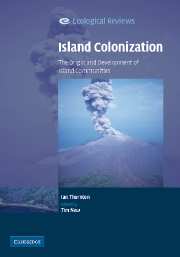Book contents
- Frontmatter
- Contents
- Editorial preface
- Acknowledgements
- PART I Theoretical and experimental studies
- PART II Natural recolonization after devastation
- PART III The recolonization of devastated islands
- PART IV Assembly of biotas on new islands
- 9 Lake Wisdom: a new island of fresh water
- 10 New islands in the sea
- 11 Anak Krakatau, Krakatau's child, b. 1933
- 12 Surtsey, Island of Surtur, b. 1963
- 13 Motmot: an emergent island in fresh water
- PART V Colonization and assembly
- References
- Index
13 - Motmot: an emergent island in fresh water
Published online by Cambridge University Press: 12 January 2010
- Frontmatter
- Contents
- Editorial preface
- Acknowledgements
- PART I Theoretical and experimental studies
- PART II Natural recolonization after devastation
- PART III The recolonization of devastated islands
- PART IV Assembly of biotas on new islands
- 9 Lake Wisdom: a new island of fresh water
- 10 New islands in the sea
- 11 Anak Krakatau, Krakatau's child, b. 1933
- 12 Surtsey, Island of Surtur, b. 1963
- 13 Motmot: an emergent island in fresh water
- PART V Colonization and assembly
- References
- Index
Summary
Birth and physical development
Between 1969 and 1972, 50 km off New Guinea's north-east coast, there was an island in which there was a lake in which there was an island in which there was a lake. This intriguing Chinese-boxes system began during the 1968 eruption on Long Island.
In spite of its large caldera, Long Island was not recognized as an active volcano until 1943, when, on a US Army 1-inch-to-1-mile map of the island, a crescent-shaped shoal, not present in 1938, was shown just to the south of the middle of the caldera lake some 5 km from the nearest shore, and labelled ‘active crater’. This must have been eroded away (winds on Lake Wisdom can be strong and waves high) because it was not to be seen in 1952. Between 1953 and 1955 intermittent Surtseyan activity was reported at the same site and a second island was formed, and there was probably a further eruption in 1961. By 1968 this island was represented only by a flat-topped islet 170 m by 70 m, a smaller rocky islet of scoria and boulders, and an even smaller fin-like spine 15 m long.
New activity was observed in 1968 (D'Addario 1972). On 19 and 20 March there was a disturbance in the sea at a point which had been the site of fumarol activity on the shoreline of the 1953–55 island, and a horseshoe-shaped crater, opening to the north, appeared above the water surface.
- Type
- Chapter
- Information
- Island ColonizationThe Origin and Development of Island Communities, pp. 185 - 202Publisher: Cambridge University PressPrint publication year: 2007



